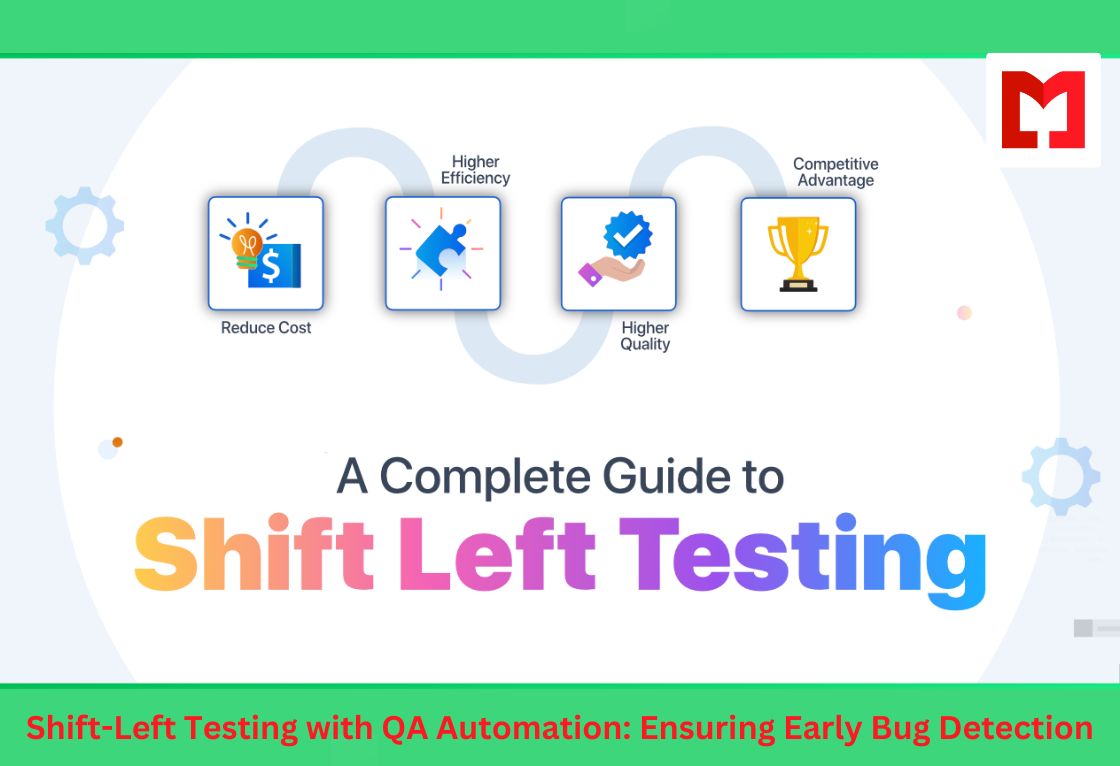1. Introduction to Shift-Left Testing
Shift-left testing is an approach to software testing where testing activities begin earlier in the development process. By identifying and fixing bugs in the initial stages of development, teams can save time, reduce costs, and deliver higher-quality software. QA automation plays a vital role in implementing this approach effectively.
In this blog, we will explore how shift-left testing combined with QA automation testing services can improve your software development lifecycle and ensure early bug detection.
2. Benefits of Shift-Left Testing
- Early Bug Detection: Bugs identified early are easier and cheaper to fix.
- Improved Collaboration: Developers, testers, and business analysts collaborate from the start.
- Reduced Costs: Fixing defects early reduces rework and overall project costs.
- Faster Releases: Continuous testing ensures that issues are addressed before they become bottlenecks.
- Better Software Quality: Testing throughout development results in fewer issues in production.
3. Role of QA Automation in Shift-Left Testing
QA automation is essential for shift-left testing as it enables teams to:
- Automate repetitive tasks, saving time and effort.
- Run tests continuously during development.
- Validate code changes quickly and efficiently.
- Identify defects in real-time using tools integrated with CI/CD pipelines.
4. Popular Tools for QA Automation in Shift-Left Testing
1. Selenium
Selenium testing services is widely used for automating web application testing:
- Supports multiple programming languages like Java, Python, and C#.
- Integrates seamlessly with CI/CD tools.
- Ideal for regression and functional testing.
2. Appium
Appium testing services is perfect for mobile application testing:
- Supports native, hybrid, and mobile web apps.
- Works across iOS and Android platforms.
- Allows script reuse between iOS and Android tests.
3. JUnit
JUnit is a popular tool for unit testing in Java applications:
- Ensures that individual units of code function as expected.
- Provides detailed test reports.
- Integrates with CI/CD tools for continuous testing.
4. Jenkins
Jenkins automates the CI/CD process:
- Runs automated tests after every code change.
- Provides instant feedback on test results.
- Allows easy integration with QA automation tools.
5. Steps to Implement Shift-Left Testing
Step 1: Start Testing Early
- Involve testers from the planning phase.
- Identify test scenarios and write test cases before development begins.
Step 2: Automate Test Cases
- Use QA automation tools to automate unit, integration, and functional tests.
- Run automated tests regularly during development.
Step 3: Integrate with CI/CD Pipelines
- Set up CI/CD pipelines to execute tests automatically with every code change.
- Ensure immediate feedback to developers for quick bug fixes.
Step 4: Perform Continuous Testing
- Conduct testing throughout the development lifecycle.
- Use real-time analytics to monitor test results and improve coverage.
6. AI-Powered Tools in QA Automation
AI-powered tools enhance shift-left testing by making automation smarter and more efficient. Examples include:
- Testim: Uses AI to create, execute, and maintain tests automatically.
- Applitools: Provides AI-driven visual testing to detect UI changes and errors.
- Mabl: Automates functional and API testing with machine learning capabilities.
Benefits of AI-Powered Tools
- Reduce test maintenance efforts by self-healing tests.
- Improve defect detection accuracy.
- Optimize test coverage with intelligent suggestions.
7. Best Practices for Shift-Left Testing
- Collaborate Early: Engage developers, testers, and stakeholders at the start of the project.
- Automate Strategically: Focus on automating high-priority test cases to maximize impact.
- Monitor and Improve: Use analytics to track test performance and refine test strategies.
- Train Teams: Provide training on QA automation tools and practices to ensure effective implementation.
8. How MetaDesign Solutions Can Help
MetaDesign Solutions provides QA testing and automation services to help businesses implement shift-left testing effectively. Our services include:
- Setting up and integrating QA automation tools with your development processes.
- Providing QA manual and automation testing services tailored to your needs.
- Leveraging AI-powered tools to enhance test accuracy and efficiency.
Contact us at sales@metadesignsolutions.com to learn how we can help you implement shift-left testing and improve software quality.
9. Conclusion
Shift-left testing with QA automation enables teams to detect and fix bugs early, resulting in cost savings and improved software quality. By leveraging automation tools and following best practices, businesses can streamline their testing workflows and achieve faster releases. With the right tools and expert guidance, shift-left testing can become an integral part of your development process.
Related Hashtags:
#QA #QualityAssurance #SoftwareTesting #QAAutomation #TestingServices #BugDetection #ManualTesting #AutomationTesting #SoftwareQA #TestAutomation #ShiftLeftTesting #EarlyBugDetection #ShiftLeftQA #TestingEarly #PreventBugs #ProactiveTesting #QualityFirst #EarlyTesting #TestingStrategy #QAAutomationTools #TestEarly #ContinuousTesting #CI_CD #DevOpsTesting #AutomatedTesting #CloudTesting #TestingFrameworks #TestingTools
